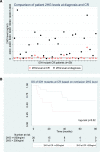Serum 2-hydroxyglutarate levels predict isocitrate dehydrogenase mutations and clinical outcome in acute myeloid leukemia
- PMID: 23641016
- PMCID: PMC3682342
- DOI: 10.1182/blood-2013-03-493197
Serum 2-hydroxyglutarate levels predict isocitrate dehydrogenase mutations and clinical outcome in acute myeloid leukemia
Abstract
Cancer-associated isocitrate dehydrogenase (IDH) mutations produce the metabolite 2-hydroxyglutarate (2HG), but the clinical utility of 2HG has not been established. We studied whether 2HG measurements in acute myeloid leukemia (AML) patients correlate with IDH mutations, and whether diagnostic or remission 2HG measurements predict survival. Sera from 223 de novo AML patients were analyzed for 2HG concentration by reverse-phase liquid chromatography-mass spectrometry. Pretreatment 2HG levels ranged from 10 to 30 000 ng/mL and were elevated in IDH-mutants (median, 3004 ng/mL), compared to wild-type IDH (median, 61 ng/mL) (P < .0005). 2HG levels did not differ among IDH1 or IDH2 allelic variants. In receiver operating characteristic analysis, a discriminatory level of 700 ng/mL optimally segregated patients with and without IDH mutations, and on subsequent mutational analysis of the 13 IDH wild-type samples with 2HG levels >700 ng/mL, 9 were identified to have IDH mutations. IDH-mutant patients with 2HG levels >200 at complete remission had shorter overall survival compared to 2HG ≤200 ng/mL (hazard ratio, 3.9; P = .02). We establish a firm association between IDH mutations and serum 2HG concentration in AML, and confirm that serum oncometabolite measurements provide useful diagnostic and prognostic information that can improve patient selection for IDH-targeted therapies.
Figures





References
-
- Paschka P, Schlenk RF, Gaidzik VI, et al. IDH1 and IDH2 mutations are frequent genetic alterations in acute myeloid leukemia and confer adverse prognosis in cytogenetically normal acute myeloid leukemia with NPM1 mutation without FLT3 internal tandem duplication. J Clin Oncol. 2010;28(22):3636-3643. - PubMed
-
- Abbas S, Lugthart S, Kavelaars FG, et al. Acquired mutations in the genes encoding IDH1 and IDH2 both are recurrent aberrations in acute myeloid leukemia: prevalence and prognostic value. Blood. 2010;116(12):2122–2126. - PubMed
-
- Chou WC, Hou HA, Chen CY, et al. Distinct clinical and biologic characteristics in adult acute myeloid leukemia bearing the isocitrate dehydrogenase 1 mutation. Blood. 2010;115(14):2749–2754. - PubMed
Publication types
MeSH terms
Substances
Grants and funding
LinkOut - more resources
Full Text Sources
Other Literature Sources
Medical
Miscellaneous

